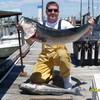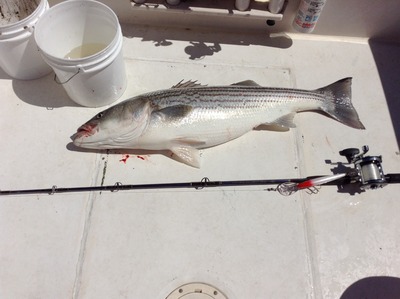Raritan Bay Spring Striper clamming tips
Every week at the dock, I hear the same old complaints. The fish were just mouthing the clam bait but would not eat it. I get a bite but when I go to set the hook, nothing. The garbage fish were just stealing the clam bait. And yet, I have a boat limit of nice size Stripers. What's going on? The problem is in the very early spring the water temperature is very cold and the Bass are very lazy. So you have to adjust your tactics. I have listed a couple tricks I have learned over the years while guiding fishing charters on my boat PrimeTime to help you be more successful on your spring trips.
- Use light tackle. I usually break-in my Fluke combos for the early run where you will be fishing in fairly shallow, 6 20ft, bay waters with mild currents. I use between 10 to 15 lb test mono line with a sinker slide and a 2 to 3 oz bank sinker. The sinker slide fish finder is very important and one of the keys to feeling the light bite in these conditions. I usually use a 6/0 octopus hook on a 24 to 36 inch, 20 to 30 lbs leader attached to a barrel swivel. This will work on virtually any decent Fluke combo as long as it has a conventional reel with a good quality drag system.
- Use Fresh Clams. I always have my guys change their bait frequently. After getting a hit, wait a minute or two for a follow up hit, then put on new clam bait. The Bass like the juicy stuff that hangs from the clam belly (the snot). The snot is like candy to the bass. It is the easiest to grab and what the bass grab on their first bite. If you try to come tight on this first bite the bass will swim away with the snot in their mouth and you will be left with the belly.
- Check your bait frequently. If you have not had a hit in a while check your bait. Remember these fish hit very light and you might be fishing with an empty hook. It's hard to catch fish that way! The bait could also be washed out and all of the scent could be gone. I can't tell you how many times when we get a lull in the bite and I tell the guys to check their bait, it is either gone or washed out. When they put fresh bait on their hooks, amazingly the fish start biting again.
- Hold the rod. Always hold the rod in your hands. Leave the reel in free spool, no clicker, with very light pressure on the spool. When you feel the slightest movement on the line take pressure off the spool and feed the line to the fish quickly until you feel a steady flow of line coming off the reel. Remember they only have the snot in their mouth and you want the fish to take another bite where the hook is embedded. Once the fish is making a steady run you can set the hook, or raise the rod and start reeling if using a circle hook.
The lesson here is that when fishing for Stripers in colder water, fewer than 55 degrees, you need to change your tactics. Think light because the bass are moving slow in this cold water. Save the dead sticking for when the water warms and the fish are more aggressive. I always use these tactics on my early Striped Bass charters and have had great success over the years.
Tight Lines
Capt. Karl
www.PrimeTimeCharters.homestead.com



